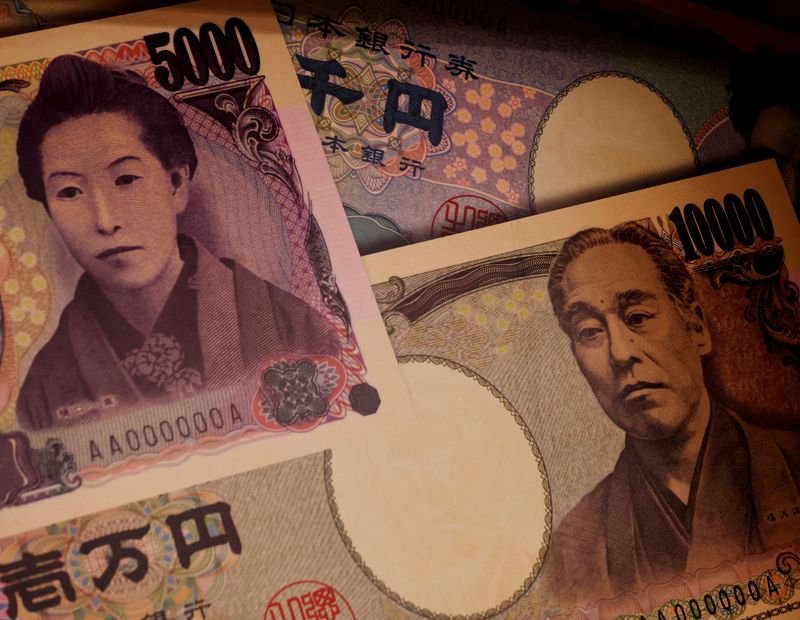By Amanda Cooper and Brigid Riley
LONDON/TOKYO (Reuters) -Japanese official buying to defend the yen is quickly becoming a standard feature of the FX landscape in 2024, but authorities in Tokyo have changed their methods, making it even harder for investors to second guess when and how they could intervene.
The new intervention tactics may have wrong-footed traders enough to help Japanese financial authorities turn the tide for their currency, which hit its weakest point against the dollar since 1986 just four weeks ago.
The Bank of Japan, at the insistence of the Finance Ministry, is likely to have spent nearly 6 trillion yen ($38.4 billion) this month to support the yen.
While the dollar was trading at a 38-year high around 160 yen two weeks ago, authorities in Tokyo warned almost daily that they would intervene if volatility proved excessive or if the level of the Japanese currency undermined the underlying economic and monetary policy reality. would not reflect. A new round of intervention was therefore no surprise.
There has been no official confirmation of intervention, but when the first round of a one-two punch arrived on July 11, traders believe the BOJ pounced on weak US inflation data that hit the dollar, sending dollars into the US currency’s trap are sold. rather than in yen weakness.
The dollar/yen pair, now below 155 yen, fell from 161 to around 158.3 in a matter of minutes, immediately raising suspicions of intervention among traders.
“It appears that the MOF and the BOJ have become a ‘momentum trader’ and seized their moment to enter the market when it was at its most vulnerable,” Chris Weston, market strategist at Pepperstone, said at the time.
Normally, the BOJ would intervene when US Treasury yields and the dollar rose.
“It wasn’t like that this time. In fact, during a sell-off in the dollar, which caused the dollar/yen to fall, we saw this unusual shift in the yen,” Hiroyuki Machida, director of Japan FX and commodity sales at ANZ, said.
“Assuming that the dramatic and abrupt move of the yen in a short period of time was due to intervention, it was indeed different from the patterns we have seen in the past,” Machida said.
A second round of suspected official buying on July 12 made investors so nervous that a new rally in the yen on July 15 initially depended on intervention, which market data later showed was unlikely to have occurred.
Bank of America, which has argued for some time that the BOJ could opt for routine interventions like the Swiss National Bank, says the Japanese authorities may have had three objectives in mind: maximizing the impact, increasing the element of surprise and warding off excesses. speculative movements.
JOB DONE?
It seems to have worked. The yen has appreciated by almost 4% this month and options positioning is starting to shift.
Traders are less confident than they have been for some time that the yen is on a one-way path toward more weakness.
The derivatives market shows that the premium in the price of options to buy the yen a month from now is growing compared to the price of put options – an indication that traders are becoming more bullish.
The main cause of the yen’s 30% decline over the past four years is the discount in Japan’s interest rates compared to elsewhere, but especially in the United States.
The BOJ meets on July 31 to set monetary policy and a very mixed set of economic data means the chances of a 0.1% rise are about 50/50.
The Federal Reserve, meanwhile, will almost certainly cut rates by a quarter of a percentage point to a range of 5.00-5.25% at its September meeting.
MUFG FX strategist Lee Hardman said the currency’s moves in July “suggest Japan needs a change in strategy to be more proactive rather than reactive in providing support to the yen.”
Speculators still have one of the biggest bets on the yen ever. At nearly $12 billion, it has more than doubled since the start of 2024 alone.
ANZ’s Machida said with a bearish position of this magnitude, the prospect of a more unpredictable intervention was “scary.”

‘It’s incredibly painful. You may have been sitting pretty and thinking you had made a profit at 161 yen, but now it’s at 156 yen. If the Bank of Japan intervened at this level, at 156 yen, you would. I probably just want to throw in the towel.”
($1 = 156.1000 yen)


